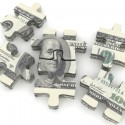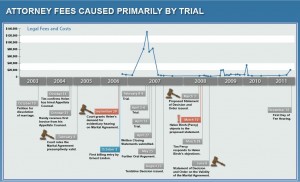Menu

Morgan Smith
Three Tips for Attorneys to Present Economic Data (and Not Be Boring)
 At a recent seminar I attended, Judge M. Lynn Duryee of the Marin County Superior Court had a great story of an attorney who stood up in opening statement and said, “I’m going to call an economist who will testify about the damages caused by the negligence of Defendant, but I warn you it’s going to be really boring.” Many attorneys would not be so bold as to warn the jury that the economic loss part of the case is going to be boring, but I’ll bet many do think that every time.
At a recent seminar I attended, Judge M. Lynn Duryee of the Marin County Superior Court had a great story of an attorney who stood up in opening statement and said, “I’m going to call an economist who will testify about the damages caused by the negligence of Defendant, but I warn you it’s going to be really boring.” Many attorneys would not be so bold as to warn the jury that the economic loss part of the case is going to be boring, but I’ll bet many do think that every time.
Ask yourself if any juror is likely to remember something that is boring, and the answer clearly is no. The question attorneys should ask themselves is, “Does my presentation on economics have to put everyone to sleep?” The answer again is no. This post will provide a few key tips on how to transform economic data into engaging, easy-to-understand visual presentations.
One of the most difficult parts of presenting any case involves economics, especially when it comes to showing the valuation of the claimed loss that the case is really about. We attorneys often spend the vast majority of our time thinking about liability while working up a case, with less thought given to the actual calculation of the loss beyond a general concept. The reason for this is fairly obvious, because without liability there is no payable loss, so both sides tend to fight the case strongest on the liability issue.
When it comes to mediation or trial, this same mindset often dominates insofar as the majority of the attorney’s time is spent preparing the liability side of a case, while leaving the damage loss to the accountants or economists who will testify about the specific numbers. I get the feeling that one reason attorneys do not get into the economic loss presentation heavily is that they find it boring themselves and figure they will get through it as quickly as possible at trial. This, however, is a potentially huge mistake and a loss of an opportunity to make your numbers sing, while the other side’s numbers fall flat.
Taking economic valuation testimony and making it interesting should be a crucial part of any case preparation, especially considering the problem that is presented by the hearsay rule. While I have certainly seen more opposing counsel than not fail to object to the admission of an expert economist report as hearsay, it most certainly is. (It is an out-of-court statement used to prove the truth of the matter stated, that clearly is not a business record or other hearsay exception.) So if you cannot admit the expert’s report, how do you possibly get the information to the jury in an interesting way they will remember? Here are three tips I advise:
1. Work with your expert early to develop a visual presentation that will be shown during testimony.
Any economic loss or valuation should absolutely, no exception, have a visual component to the presentation that includes well-done graphs or charts, and/or other graphics such as timelines. Retention of information is six times greater when information is presented by visual and oral means than when the same information is presented by the spoken word alone.5 (U.S. Dept. of Labor, “Presenting Effective Presentations with Visual Aids,” available at https://www.osha.gov/doc/outreachtraining/htmlfiles/traintec.html.) Economic issues are a clear example of both showing and telling for jury retention.
Below is an example from an attorney fee request, showing that the majority of the disputed fees were caused by the trial. While an economist can certainly testify to this fact, a timeline with a graph above it clearly shows that fact for better retention.

The graph above combines a timeline with economic data to help visually explain that the vast majority of the fees related to the case occurred as a result of the trial in the case. By combining both the timeline and data, the viewer immediately “gets” the relationship and the reason for most of the requested fees.
2. Build your economic evidence piece by piece.
For economic presentations, the key to keeping the jury attention is the speed and order in which you present the evidence to them. Researchers Whitman and Woodward recently demonstrated this effect by studying whether showing evidence one step at a time or all at once affected how strongly people felt about their conclusion. The study found that “gradual evidence accumulation increased the effects of evidence strength.”
In other words, if people are given evidence step by step, they are much more likely to feel that all the evidence taken together is stronger than if they are given all the evidence at once. People understand evidence better if broken down and built for them. When economic testimony is involved, break down each piece in a visual manner so any information “builds” as the testimony addresses it. This method keeps interest, and you are more likely to persuade the jury.
3. Provide a summary of economic valuation.
In order to avoid a hearsay objection, make sure your expert prepares a good summary of his or her report that has no opinions or hearsay, and only includes the ultimate numbers. The judge has discretion to admit a summary of evidence if it is helpful to the jury. Most any judge will allow a summary of the findings so the jurors do not have to write down all the numbers themselves and risk getting them wrong. However, if the “summary” includes inadmissible hearsay such as quotes from other sources, findings and background details, it will likely be excluded.
Another alternative is to use the old-school method of having the expert write all the ultimate numbers on butcher paper in front of the jury and admit that document as a summary that is helpful to the jury. However, never rely on the jury to simply write down the key numbers.
Conclusion
The key to a good economic valuation testimony is working early with your expert to develop a plan of visual presentation that will highlight the essential points of his or her testimony. Since people retain information far better if presented both visually and verbally, definitely get that economic valuation testimony into visual form for mediation, hearings or trial.
Recent Posts
- Proper Digital Discovery, Part IV: Using Drones in Modern Litigation
- Proper Digital Discovery, Part III: Using Digital Imagery in Modern Litigation
- Proper Digital Discovery, Part II: Electronic Measuring Data
- How to Obtain Proper Digital Discovery, Part I: Photography
- California Courts – Latest Updates
